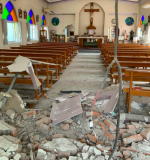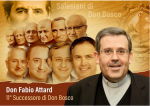Mumbai, Nov. 4, 2018: A year shy of retiring, when he turns 75, Father Jude Botelho, parish priest of the Church of Our Lady of Glory, Byculla, popularly known as Gloria Church, can’t help but look back at the last four years as a lesson in art history.
Back in the early 1970s, the priest had been part of the team that oversaw the construction of St Paul’s Church in Dadar, but restoring and repairing churches aren’t what he’d call his forte.
Yet, in 2014, when he came to the Church of Our Lady of Health, Cavel, the centuries-old structure whose teakwood interiors were eaten away by white ants, called for immediate attention.
No sooner had he completed the repairs of that church in 2016, Fr Botelho was moved to Gloria, where he was tasked with completing the restoration of the 160-foot-tall heritage landmark, which finally opened its doors to parishioners October 28.
“I think, I should call myself the repairer of old churches,” Fr Botelho jokes, when we meet him at his office on a weekday. “But, yes, it has really opened up my mind.”
Repair. restore. repeat
For someone his age, with health putting him on the back foot, the task of repairing and restoring two of Mumbai’s oldest churches, was doubly challenging.
“The church at Cavel was, in fact, in a very bad state. The staircase inside the church was completely eaten by white ants; so were the wooden altars on the side. We, unfortunately, could not salvage anything. There was the additional problem of water seepage inside the church. We had just finished painting the church, when we realized that the water from below had risen by 14 feet, and destroyed the walls,” he recalls.
Father Melroy Fernandes, who was also part of the parish, brought in his expertise in art to the table, and ensured that the right consultants were onboard to repair the church.
They would have liked to restore the church, which is situated in Kalbadevi, but with a sparse parishioner population of just about 200, it was difficult to accumulate funds for the same.
Today, the main altar, which boasts of an intricately carved wooden structure, painted in gold, continues to represent the worth of Cavel’s heritage. The new additions are paintings from the Bible recreated on plastic sheets – an idea that Fr Botelho credits to Fr Fernandes – that are fitted to its huge windows.
Where Cavel has historical value, Gloria, built in Gothic style, was a heritage monument, “which for history’s sake, had to be restored to its original glory”.
The work on the restoration of Gloria built in 1911 – the original structure was constructed in the 1600s – had begun nearly six years before Fr Botelho joined the parish early last year.
Renowned city architects Ainsley Lewis and David Cardoz, who have a history in heritage conservation, were roped in for the project, along with stained glass expert Swati Chandgadkar. “The stained glass work in this church is most unique, and cannot be found anywhere else in Mumbai,” he says.
The entire glass frame, which comprises several different parts that are stuck together with the help of a solution, had to be brought down and worked upon piece by piece.
Fr Botelho again roped in Fr Fernandes to suggest the choice of colors – white and light brown – for its huge arches and pillars. “The colors on the glass and walls complement each other really well. You wouldn’t believe me if I said the church looks different during the day and in the night.”
Funding for the churches
The funding for both the church projects came from the parishioners and donors from other churches, says Fr Botelho. While repairs at Cavel cost nearly R2 crore, restoration at Gloria came to three times the amount.
“People usually wait to see [the progress of the work], before they contribute,” he says. With Cavel, which was once a thriving Christian pocket, they had to create enough buzz on social media, to draw the interest of ex-parishioners, now settled abroad, to be generous in their donations.
With Gloria, too, while its worshipers whittled down from 20,000 in the ’70s to 3,000, former members were more than forthcoming.
“What I learned from both the experiences is that you have to give them [the parishioners] sufficient information on the repairs, but not consult too many of them. It is important to listen to everyone, but do what you think is right and for the good of the church and its people.”
(Midday)









